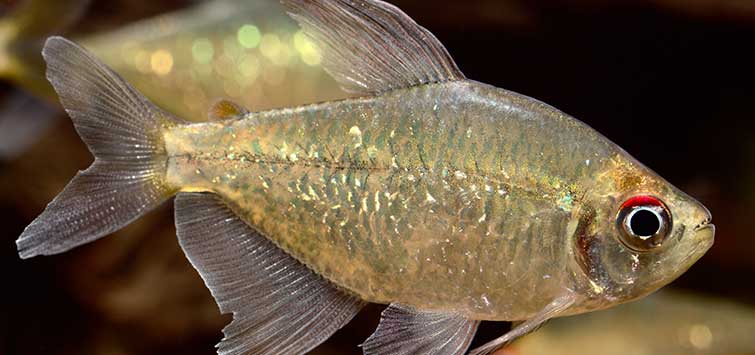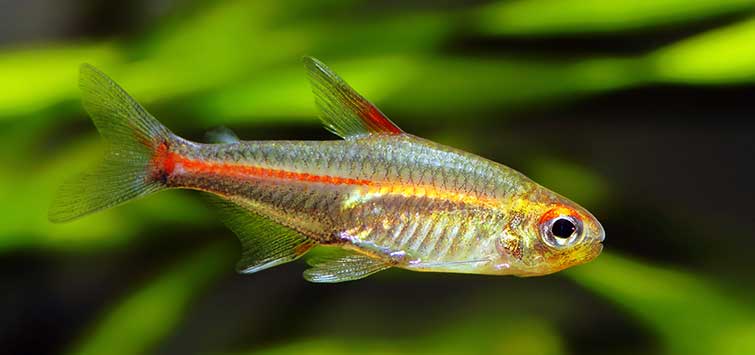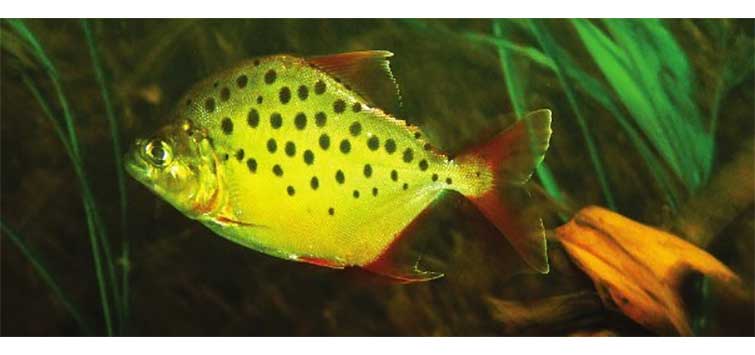First-Ever Photos of Diamond Tetras in Their Natural Habitat
Author: Ivan Mikolji
Our fearless explorer offers a glimpse into the disappearing realm of Moenkhausia pittieri, a popular species in the hobby that faces near-certain extinction in the wild.
Moenkhausia pittieri 101
When thinking about freshwater fish that are nearing extinction in their native habitats, the blue-eyed pleco Panaque suttonorum or the zebra pleco Hypancistrus zebra probably come to mind, but you might never think of the common aquarium fish Moenkhausia pittieri. Yes, the diamond tetra! Even though this small characiform is very prolific and can be bred quite easily in the aquarium hobby, it is disappearing in the wild.
The ornamental fish known as tetras belong to the Tetragonopterini tribe, which includes genera such as Astyanax, Bryconamericus, Hyphessobrycon, Paracheirodon,and Moenkhausia. This group is characterized by an internal row of teeth from the premaxilla, composed of five or more teeth on each side. Other distinguishing characteristics are the big suborbital bone under the eye, with the area partially scaleless, and the lack of a ventral keel.
The genus Moenkhausia, named after the zoologist William J. Moenkhaus, can be distinguished by a strongly dented maxilla, as well as disordered scales before the dorsal fin without forming a line (irregular pre-dorsal line). At least a quarter of the tail fin is scaled, and the body features ctenoid-type scales (their scales have small spines on their surface) that feel rough to the touch when the fish is stroked from tail to head.
M. pittieri was named after the biologist Henri F. Pittier. A distinctive characteristic of the species is that its body is covered with golden, iridescent scales. In the wild their dorsal and anal fins show a violet coloration, the caudal peduncle is yellowish, and their dorsal fin sometimes presents a white line.
Diamond tetras are autochthonous to the Lake Valencia Basin. Actually, the holotype or original specimen used to describe the species by Carl H. Eigenmann in 1920 was caught in the Tiquirito River in El Cosejo, in Aragua State, Venezuela, which is one of many small streams that drain toward Lake Valencia. They are currently taxonomically classified as follows: class Actinopterygii, order Characiformes, family Characidae, subfamily incertae sedis.
Lake Valencia
Lake Valencia is located in an enormous valley surrounded by mountains. The lake gets its waters from many little mountain streams. What makes this lake so special is that it has no outlet streams or rivers, and it does not connect to any main river system or ocean. Its water levels are controlled by rainfall and evaporation.
The great majority of the small streams around Lake Valencia have been contaminated by raw residential and agricultural industrial sewage, which is introduced when untreated wastewater enters the stream or lake, causing algae blooms that have a direct impact on all aquatic life.
My First Encounter
After looking for diamond tetras for more than three years without luck, a friend of mine, Simeon Perez, told me that he knew of a place where there was a stable population in clear waters. After making me promise never to give the exact location out to anybody, he took me to his secret spot.
The Creek
Simeon’s secret creek was a typical M. pittieri mountain river habitat, which often have clear waters and cold temperatures. It had a coarse gravel bed with an abundance of large river rocks. The water was never more than 5 feet deep, with a foot being the average depth. The pH was 7.8 (slightly basic) with a temperature of 25°C (77°F).
Simeon told me that the water was basic due to the large amounts of limestone rock that form part of the bottom substrate. The low temperature of the water is due to the tall, dense trees that grow along the creek banks and prevent much of the direct sunshine from penetrating the water. These small creeks stop flowing in the dry season, and the diamond tetras, along with all the other fish that inhabit the creek, get caught in large puddles. The tall trees seem to be crucial for their existence, for they keep these puddles from drying up for up to five to six months until the rainy season starts again. The trees also prevent the water from getting too warm for them to live in.
I found no submerged aquatic plants in the creek—the few species of aquatic plants I found were the partially submerged type, which grow half-in and half-out of the water. In other aquatic biotopes, fish use aquatic plants as shelter from predators. Because of the lack of aquatic plants, diamond tetras use the abundant driftwood and larger rocks as shelter, but the most important factor in their survival in the wild is their quick acceleration and fast swimming speed.
Photographic Challenges
Current
Photographing this species underwater in its natural habitat was a real challenge. The one-foot-deep water had a strong current and the creek bed was full of oddly shaped rocks, some protruding out of the water, which made it almost impossible for me to lay flat. Even with a 10-pound lead belt on, I was still being dragged downstream. The water was so shallow that it was almost impossible to submerge my head; it was even practically impossible to keep my head upright underwater. I had to take the pictures with my head submerged sideways so I could look at the camera screen. Another challenge was the lack of light due to the abundant trees, which blocked all direct sunlight, necessitating a longer exposure time.
Tough to Capture
Added to this was another problem: The fish swam by as fast as they could—some fought the current and swam upstream, while others passed by with lightning speed coming back downstream. Once I pressed the shutter button to take a picture, the diamond tetras were either gone, or I was left only with the end of their tails or a blurry picture. I wound up having to anticipate their movements and guessing their locations as much as a second before taking each shot. Adding to the situation was the usual hypothermia that always kicks in around 40 minutes after being submerged in 25°C (77°F) water. Naturally, uncontrollable shivers increase the difficulty of getting a great photo.
Silt
In the deeper areas of the creek or pools, it was much easier to lie still because of the slower current, but these sections of the creek bed were covered with a thick layer of silt. Once you entered a deep area and placed your foot down, a cloud of silt would be created, leaving the small pool of water murky and difficult for taking any pictures for more than an hour. In two days of photographing, I took about 900 pictures but only wound up with a couple of decent shots.
Results
Though the M. pittieri mountain creek habitat is essentially monotonous and monochromatic, lacking the coloration and diversity of other aquatic biotopes, these photos—the first of their kind—show what their true home looks like. As I know that good aquarium pictures of most fish can be found almost anywhere, my emphasis was on taking pictures of the diamond tetra’s habitat, which is hard to find because it is practically nonexistent.
Other Fish in the Region
After snorkeling in the small creek for two days, we spotted many other fish that share M. pittieri’s habitat and coexist with them in the wild. It was amazing to see how sophisticated nature works in these small, confined habitats; I’ll try to explain why as well as I can.
Predatory Fish
Two of the species of fish that inhabit their confined habitats are wolf fish Hoplias malabaricus and pike cichlids Crenicichla sp.aff geayi. Now, if you place these two fish in any aquarium, it would be extremely hard for any tetra to survive, much less thrive. These two predatory fish are very voracious.
Small Tetra Species
So how does nature even things out? Well, there are great numbers of very prolific fish such as wild guppies Poecilia reticulata, and many other small tetra species like Corynopoma riisei, as well as other tetras I could not identify. These other tetras and guppies are easier prey, being slower swimmers and smaller in size than Moenkhausia pittieri, which makes them easier for the predators to catch and swallow.
Other fish we spotted inhabiting the creek with the diamond tetras were Corydoras aeneus and plecos Ancistrus spp. They were in charge of cleaning up after everybody’s mess. Easy-going Aequidens pulcher cichlids could also be seen, minding their own business and staying out of any trouble.
The adult male diamond tetras were much larger in size than the adult females. The biggest males we saw were around 5½ cm (2 inches) long. The females were half that size. The adult males could also be easily differentiated from the females because the first rays of the dorsal, anal, and pelvic fins are elongated.
We also observed that they are a midwater dweller, only going to the surface if something that looked like food fell in the water. Their feeding patterns are basically opportunistic, capturing anything that falls or moves on the water’s surface and would fit in their mouths. Their feeding tendency is principally carnivorous, with their most common prey being ants, termites, small moths, flies, mosquitoes, and small wasps.
An Uncertain Future
In many years of study around Lake Valencia’s rivers and creeks, I have noticed that many fish are highly tolerant to contaminants. The highest tolerance can be found in Poecilia reticulata, followed by Aequidens pulcher. Moenkhausia pittieri is one of the extremely susceptible species that, like a canary in a coal mine, seems to be the first to disappear when a body of water starts deteriorating.
Unfortunately, perhaps the only way to ensure the survival of this beautiful characiform in the wild would be to buy the land around the source of this small creek and create a wildlife reserve, preserving what could be one of the last natural habitats of diamond tetras.
I hope that diamond tetras will continue to exist in the wild, but their future looks quite dim to me. If you ever breed diamond tetras in your home aquarium, always remember that there are practically none left in the wild.
Acknowledgements
Special thanks to Yoliana AÑanguren from the UCV (Central University of Venezuela) for providing me with scientific details of the Moenkhausia pittieri species.
See the full article on TFH Digital http://www.tfhdigital.com/tfh/20101/#pg69

.png?h=595&iar=0&w=2781&hash=5FD5E69473BCC22199FBFA2FB71B6033)



